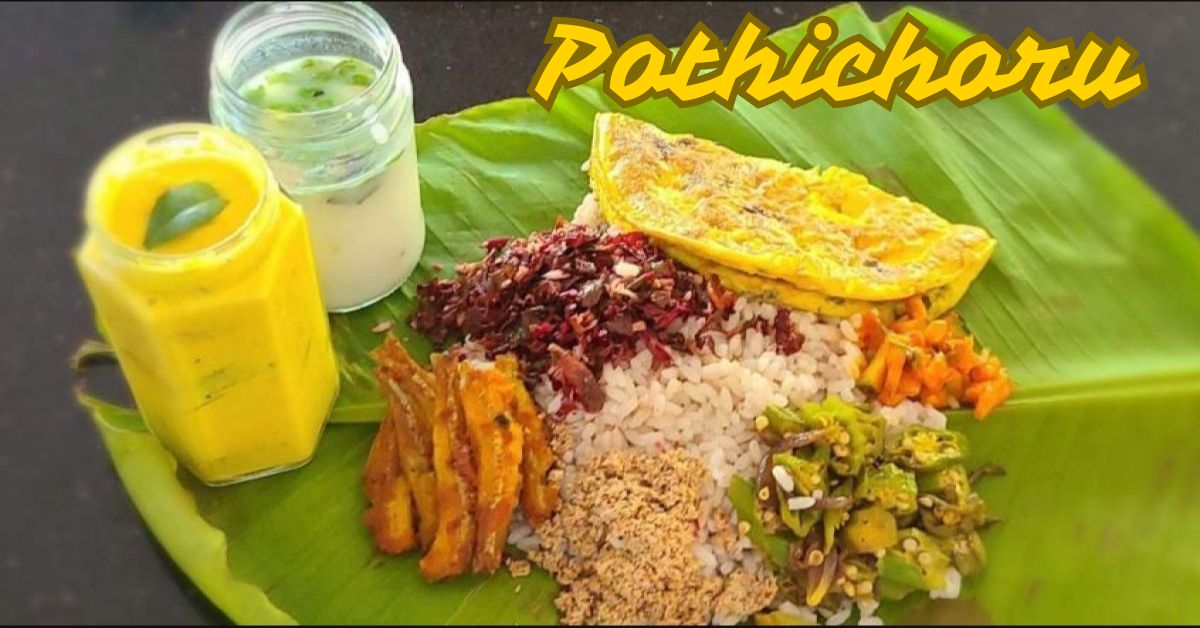Pothichoru, a traditional style of serving meals in Kerala, India, encapsulates not just a culinary experience but a cultural tradition deeply rooted in community and simplicity. This article explores the significance, preparation, and cultural relevance of Pothichoru.
Introduction to Pothichoru
Pothichoru, also known as “meal wrapped in plantain leaf,” is a traditional way of serving and enjoying a complete meal in Kerala, South India. The term “Pothichoru” derives from Malayalam, where “Pothi” means bundle or package, and “Choru” translates to rice.
Cultural Context
Pothichoru isn’t just a method of serving food but represents communal dining and hospitality ingrained in Kerala’s social fabric. It’s often associated with home-cooked meals and the warmth of sharing food with others.
Components of Pothichoru
Plantain Leaf
Central to Pothichoru is the use of fresh plantain leaves, which are eco-friendly and impart a unique aroma to the food.
Rice
At the heart of Pothichoru is rice, usually flavored with spices and cooked to perfection.
Curries and Side Dishes
Pothichoru typically includes a variety of curries and side dishes such as:
- Sambar: A lentil-based vegetable stew with tangy tamarind and aromatic spices.
- Avial: A mixed vegetable curry cooked in coconut paste and seasoned with curry leaves.
- Thorans: Stir-fried vegetables with grated coconut and spices.
- Meen Curry (Fish Curry): A staple in Kerala cuisine, fish curry is prepared with coconut milk, spices, and fish.
Accompaniments
Pothichoru may also include:
- Pappadam: Crispy lentil wafers.
- Pickles: Tangy and spicy condiments.
Preparation and Serving
Method
- Plantain Leaf Preparation: The leaf is cleaned and then heated slightly to make it pliable for wrapping.
- Layering: The rice is spread on the leaf, followed by the curries and side dishes, arranged in a specific order.
- Wrapping: The leaf is carefully folded into a neat bundle, ensuring that the flavors of each dish blend harmoniously.
Significance
Pothi-choru is not just about the food but the experience of eating together, fostering a sense of community and togetherness. It’s commonly associated with cultural events, festivals, and occasions where families and friends gather to share a meal.
Health Benefits
Nutritional Balance
Pothi-choru typically includes a variety of vegetables, proteins (like fish or chicken), and carbohydrates (rice), offering a balanced and nutritious meal.
Eco-Friendly
The use of plantain leaves is eco-friendly as they are biodegradable and do not contribute to environmental waste.
Conclusion
Pothichoru embodies the essence of Kerala’s culinary heritage, offering not just a meal but an experience steeped in tradition, flavor, and communal spirit. Whether enjoyed at home, during festivals, or special occasions, Pothi-choru remains a cherished part of Kerala’s cultural identity.
FAQs
- Can Pothi-choru be customized to dietary preferences?
- Yes, Pothi-choru can be customized to include vegetarian, vegan, or non-vegetarian options based on individual preferences.
- Is Pothi–choru only served in homes or also in restaurants?
- While traditionally served in homes, some restaurants in Kerala offer Pothi-choru as a specialty dish.-
- What are the benefits of using plantain leaves in Pothi-choru?
- Plantain leaves add a distinct flavor and aroma to the food, are eco-friendly, and enhance the overall dining experience.
- How is Pothi-choru different from a regular meal?
- Pothi-choru stands out due to its presentation in a plantain leaf bundle, emphasizing communal dining and traditional flavors.
- Can Pothi-choru be found outside Kerala?
- While primarily a Kerala tradition, variations of Pothi-choru may be found in other South Indian regions with similar culinary customs.










